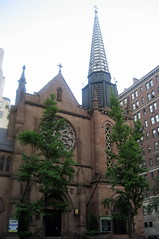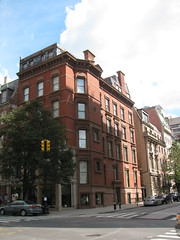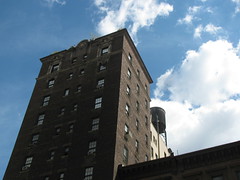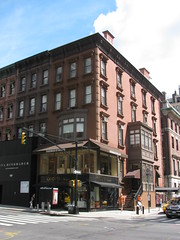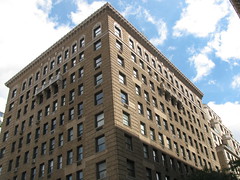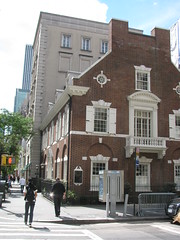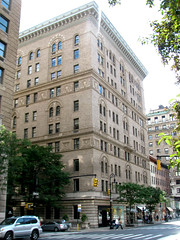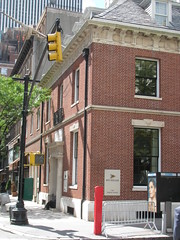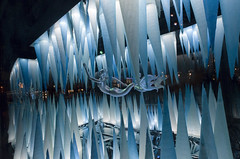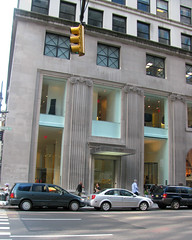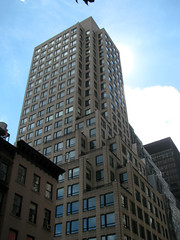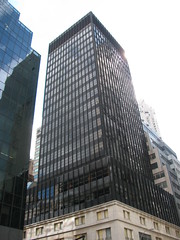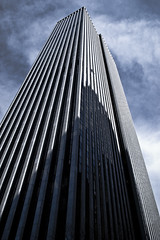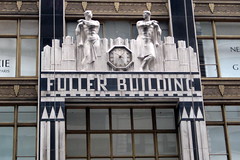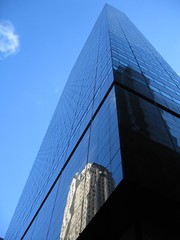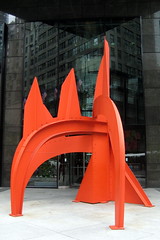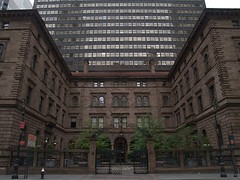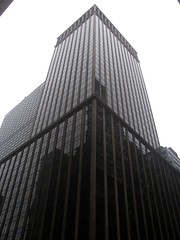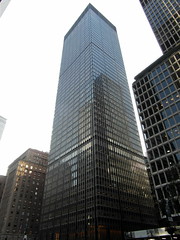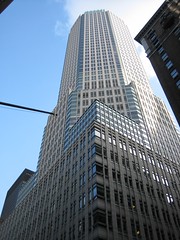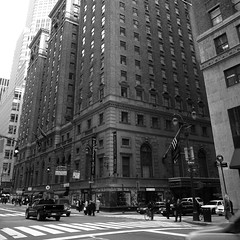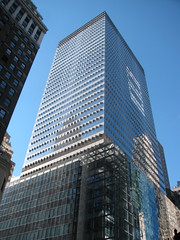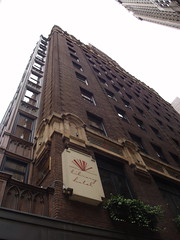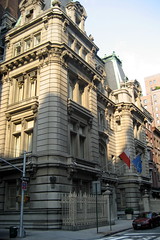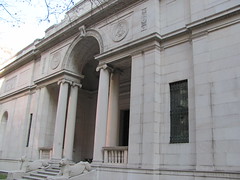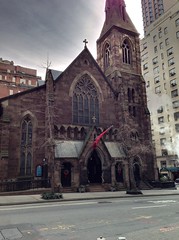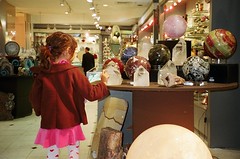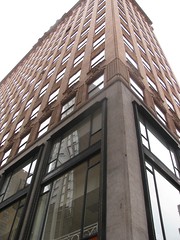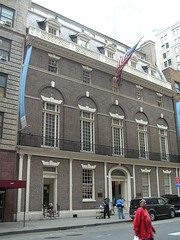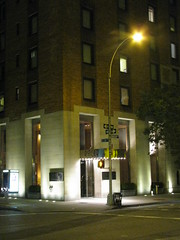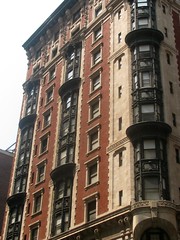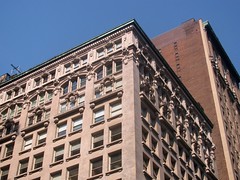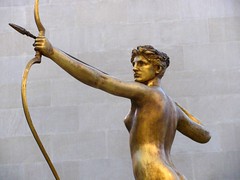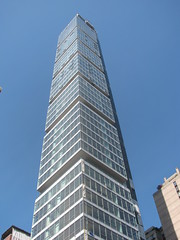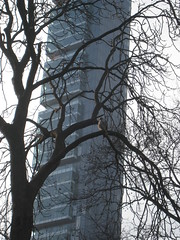West:
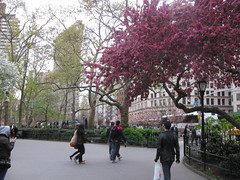
The 1807 plan set aside 240 acres in this vicinity as The Parade, to be used for military training.
In that same year, the U.S. Arsenal was
built here to defend the strategic
intersection of the Bloomingdale Road
(now Broadway) and the Eastern Post Road.
By 1814, when the park was named Madison Square
after the then-current president, it had been reduced to 90 acres.
In 1847, when Madison Square Park was opened, less than seven acres remained.
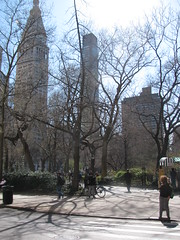
The park, which was laid out in its current form in 1870, was the center of New York society in the 1860s and '70s. "The vicinity of Madison Square
is the brightest, prettiest and liveliest portion of the great city," James McCabe wrote in 1872.
The park provides a setting for O. Henry short stories like
"The Cop and the Anthem" and "The Sparrows in Madison Square").
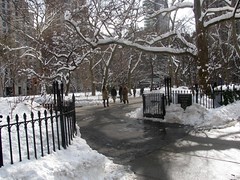
Author Herman Melville used to walk here
regularly with his grand- daughter.
During a fireworks display here celebrating the
election of William Randolph Hearst to Congress,
10,000 shells accidently ignited at once, creating
an explosion that killed 17 people.
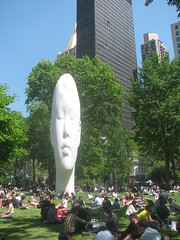
The U.S. Arsenal was converted by
1824 to the House of Refuge of the
Society for the Reformation of
Juvenile Delinquents--the first
such institution in the country.
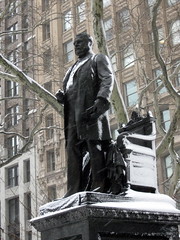 Before becoming president in 1881 after Garfield's assassination,
he lived nearby at
123 Lexington Avenue.
Statue erected 1899.
Before becoming president in 1881 after Garfield's assassination,
he lived nearby at
123 Lexington Avenue.
Statue erected 1899.
Madison Oak
Pin Oak from Montpelier, James Madison's Virginia estate,
planted 1936 to mark Madison Avenue's centennial.

An
acclaimed hot dog stand run by Danny Meyer, the
owner of Tabla and Eleven Madison, two great
(and greatly expensive) restaurants nearby.
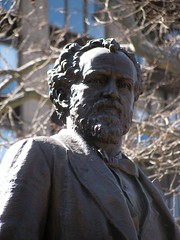
A U.S. senator and Republican machine boss who fell victim to the Great
Blizzard of 1888. This bronze was done of him in 1893 by John Quincy Adams Ward.
|
|
M
A
D
I
S
O
N
A
V
E
N
U
E
M
A
D
I
S
O
N
A
V
E
N
U
E
M
A
D
I
S
O
N
A
V
E
N
U
E
|
|
East:
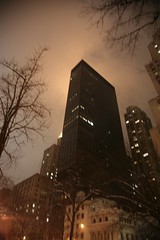
41 (corner): 1974 modernist building has
showrooms for china, silver, crystal etc.
It would look a lot less out of place if it were painted
a paler shade that better matched its neighbors.
Built on the site of the
Jerome Mansion (1859-1967),
birthplace of Jennie Jerome, Winston Churchill's mother. In 1867 the mansion became the headquarters of the Union League
Club, and later housed the
Manhattan Club, meetingplace for Democrats like Grover Cleveland, Al Smith, FDR--and birthplace of the
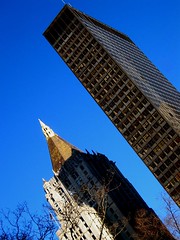 Manhattan cocktail.
Afterwards became home to the University Club for "the promotion of literature and art." Torn down in 1967 when
no buyer could be found.
Manhattan cocktail.
Afterwards became home to the University Club for "the promotion of literature and art." Torn down in 1967 when
no buyer could be found.
Merchandise Mart also replaced Madison Square Hotel, next to Jerome Mansion, where aspiring actors
Jimmy Stewart and Henry Fonda rented rooms together (1933-35). When not making names for themselves on Broadway, they
passed the time here building model airplanes. They both moved directly from here to Hollywood.
Corner (35 E 25th): Built 1900 in Italian Renaissance
style; much care was lavished on the building's
exterior and interior art, including statues of famous lawgivers
and civic virtues; the Madison Avenue balustrade features
Karl Bitter's Peace. The newer north section
of the Madison facade includes
a
Memorial to All Victims of the Holocaust
by Harriet Fiegenbaum. Landmark laws were declared constitutional
at this courthouse in 1975.
|
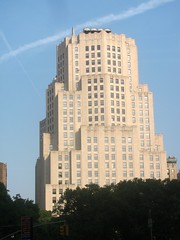
Corner (11 Madison): Built in 1929 as the Met
Life North Building, which is why the two
buildings are connected by skyways. One hundred stories
were planned, but the Great Depression stopped construction at 29,
leaving the building looking like the base of the Tower of Babel.
Expansions took over entire the block by 1950.
Designed by Harvey Wiley Corbett, it's considered
an Art Deco masterwork--
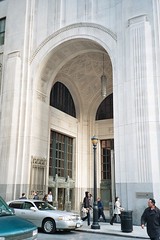 particularly the amazing corner arcades. Price
Waterhouse is a tenant here.
particularly the amazing corner arcades. Price
Waterhouse is a tenant here.
This building is also home to two expensive-but-worth-it restaurants, both owned by Union Square Cafe's Danny Meyer:
Tabla (Indian fusion) and 11 Madison Park (New American).
On Sex and the City, Big tells Carrie
he's marrying someone else at 11 Madison.
When the Madison Square Presbyterian Church was torn down to build the Met Life Tower in 1906, a new church was built
on this corner, a Greek-style temple designed by Stanford White. It in turn was torn down in 1919 to make room for Met
Life's expansion.
|
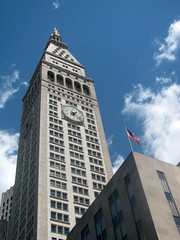
The
tower, designed by Napoleon LeBrun &
Sons in 1909, was the world's tallest building for four years
(surpassed by the Woolworth Tower). It replaced the
Madison Square Presbyterian Church (1855-1906), which was noted for
being the
pulpit of the Rev. Charles Parkhurst, a crusader against vice and corruption; his famous "undercover" tour of the
underworld is chronicled in the book Low Life.
1 (corner): The bulk of the Met Life Building was
designed by Napoleon LeBrun & Sons in 1893;
redesigned (losing much of its ornamentation) in 1957.
Griffin Dunne works here in After Hours, as does
Amanda Plummer in The Fisher King.
|
|
